Phase 1
NPS Archeology and Ethnography Program ethnographers Audrey Brown and Mark Schoepfle conducted a workshop in Rapid Ethnographic Assessment Procedures (REAP) at Chamizal NM, April 5 – 8, 2004. Its purpose was to train those in attendance for methods used in tourism impact assessment and plan a REAP research project. Rapid Ethnographic Assessment Procedures (REAP) comprise a package of ethnographic research methods that features
- the involvement of local communities and regional research and educational institutions, and
- systematic research that focuses on the perspective of local communities most closely affected by the development of tourism along historic trails.
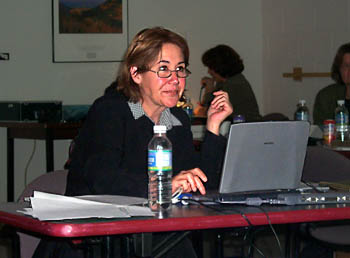
Participants included officials from
- the National Park Service's El Camino Real de Tierra Adentro NHT, Intermountain Region, Spanish Colonial Research Center (Albuquerque), and the International Conservation Programs Office
- officials from the Bureau of Land Management
- anthropology faculty and students from New Mexico State University, University of Texas at El Paso, and American University
- community officials representing the Pueblos of Ysleta del Sur, and San Juan
- representatives from the New Mexico Camino Consortium
- anthropologists and historians from the Republic of Mexico's Instituto Nacional de Antropología e Historia (INAH)
A full list of participants is in Appendix 1.
The workshop included instruction in
- the history of El Camino Real de Tierra Adentro
- an introduction to the kinds of stakeholders, or people to whom the Trail's future is important
- discussion of issues in tourism development
- training in Rapid Ethnographic Assessment Procedures
- practice in ethnographic field methods.
Workshop participants used this background as the first phase in developing research plans and proposals to conduct tourism impact assessment in selected communities along both the 400 miles of El Camino Real de Tierra Adentro in the United States, and the 1,200 miles of Chihuahua, Mexico's historical trail.
History of El Camino Real de Tierra Adentro
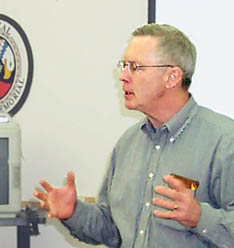
El Camino Real de Tierra Adentro is best seen through history as a braid of trails representing the distinct historic experiences of the different peoples involved with the trail, including…
- Pre-contact Indians using trails and travel routes
-
Spanish colonists, who used to road to link…
- Parajes
- Lugares
- Platas
- Villages
- Mexican nationals who used the trail as a highway linking towns in New Mexico to Mexico
- Traders and settlers from the United States who used it as an international trail and highway linking the Santa Fe and other trails in the United States to Mexico
In addition to the historical importance of this Trail to each of these groups, it is also important to the ways of life for today's descendants. Indeed, they can be seen as having a stake in how the trail's story is told.
Stakeholders
Participants proposed the following kinds of stakeholders to whom the development of heritage tourism is important. An incomplete list may include:
- Federally recognized Indian communities along the trail, including the Pueblos
- Spanish land grant and Hispanic communities
- Mexican American communities along the border
- Mexican Nationals
- Anglo American settlers
Issues
Regardless of ethnicity, the development of heritage tourism along the trail is important to these different groups in order to recognize the effects of tourism, both beneficial and adverse, and the means of mitigating the adverse ones.
The general effects of tourism are best observed and understood from the standpoints both of visitors from outside the communities affected, and those from the communities themselves. The effects of tourism due to new visitors can be beneficial because:
- the preservation of the National Historic Trail will help protect important ecosystems and heritage sites from the ravages of commercial development
- enhanced economic diversity could help end dependency on single large-employers or "middlemen"
- enhanced economic diversity could bring on new employment to people who may otherwise have to leave for more urban areas
- enhanced local employment could bring a rising tax base and income for more services and better infrastructure
- enhanced local use of certain cultural resources could be beneficial by providing incentives for local people to revitalize important but endangered aspects of their culture.
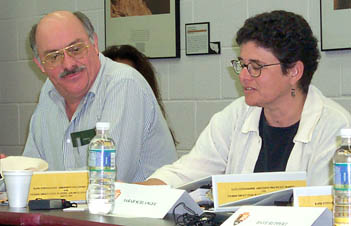
Adverse effects of tourism spring from the same causes as the beneficial effects
- preservation may also restrict local access to the resources
- rampant tourism may damage some areas or further restrict local access
- the new employment may be limited to the more educated outsiders and possibly displace locals
- cultural revitalization may give way to a "sanitized" sort of export culture that is demeaning to the heritage of local peoples
- rising land values may raise tax rates so high as to displace lower-income locals
Thus, for tourism to be beneficial, stakeholders from the local communities must be involved to guarantee that:
- important elements of the local culture are represented in a way that neither "sanitizes" nor commodifies the culture i.e., prevents the presentation of these elements in an overly simplistic or denigrating way for commercial gain, provokes undesirable culture shock among visitors from the outside, or confers an unpleasant visitor experience in other ways
- sale of cultural items is locally owned or controlled as much as possible
- the new workforce favors local residents as much as possible
- important places or locations remain accessible to local people for their enjoyment as well as to tourists from outside the areas
- differences in uses between visitors and locals of resources should be reconciled as well as possible.
NPS and other Federal government officials have a stake in addressing these issues because:
- the National Park Service's mission includes reconciling resource preservation with visitor enjoyment and education
- the General Management Plan for El Camino Real de Tierra Adentro NHT has involved extensive consultation among a diversity of stakeholders
Thus, NPS officials have expressed an interest in extending and systematizing this consultation through research that will gain further understanding from the view of the stakeholders to address the tourism issues outlined above, and to establish long-term relationships with these stakeholders as the Trail continues to develop.
Ethnographic Rapid Assessment Procedures (REAP)
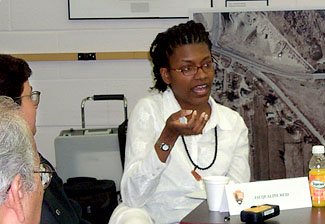
REAP is a package of ethnographic methods that systematically combines interview, observation, and documentary search techniques to describe fully the way of life common to a group of people, including their knowledge, customs, beliefs, social habits, technology, arts, values, and institutions.
It also:
- involves the active participation of people from the group
- renders this way of life from the viewpoint of the people in the group
- focuses this description to solving specific problems or addressing specific issues
Its methods include, but are not limited to:
- grand tour interviewing, which helps define the general knowledge about experiences, concerns, and other issues that need to be understood
- follow-up interviewing, which helps define further what the consultants discussed in the grand tour interviewing
- participant observation, which allows the researcher to experience what the consultant is discussing, helps triangulate or verify on the ground what the consultant is describing, and provides the opportunity to reconcile what the consultant says with what the researcher sees
- primary documentation collections of eyewitness reports and official papers that further inform what the consultant describes and the researcher observes
The following approaches combine the two kinds of interviewing with observation and documentation. They can serve either as grand tours or as follow-ups to gather still more information:
- cognitive, or projective mapping, i.e. community members drawing maps
- site walks and transect walks, with community members describing sites and objects
- event analysis, including observation and consultant description of specific events attended by both
- case analysis, including consultant description of examples defining what they are describing
- focus groups i.e. group discussions focusing on specific issues brought up by applying the other ethnographic approaches
- searches of refuse and other unobtrusive measures of local behavior that provides further information
Rapid Ethnographic Assessment Procedures (REAP) will contribute significantly to gathering the stakeholder viewpoints and to establishing long-term relationships
Strategy
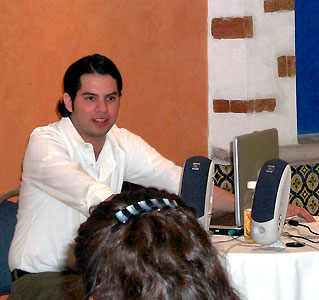
The participants outlined seven strategies for using REAP to conduct the tourism impact assessment study along El Camino Real de Tierra Adentro NHT, and along the trail system in Chihuahua, Mexico. The first, from the NHT General Management Plan, is to identify sites that are important historically and culturally, and for which further study is necessary. Criteria for selection are based on
- their status with the national register of historic places
- their importance to the community members near these sites, from their own standpoint
These sites are listed in Appendix F of the GMP as High-Potential Route Segments i.e.
…those segments of a trail which would afford high quality recreation experience in a portion of the route having greater than average scenic values or affording an opportunity to vicariously share the experience of the original users of a historic route.
The second, after identifying these sites, is to propose communities associated with these sites, where REAP can be conducted. Selection criteria include community members who have
- a stake in REAP which makes them willing to participate in a rapid assessment which implies that…
- had experience with tourism in the past, or…
- knowledge of tourism-related issues in their communities for which they may have concern or
- in other ways a stake in the development of tourism and the future of their communities
The following communities were proposed as part of this second step:
- San Juan Pueblo, at the northern end of the Trail
- Hispanic communities along the north of the Trail
- Ysleta Del Sur, adjacent to the city of El Paso, Texas
- Communities adjacent to the city of El Paso along the United States—Mexican Border
- Rural communities along the Southern part of the Trail in New Mexico
The third is to identify teams of anthropologists, students, and local community members interested in conducting rapid ethnographic assessment in these communities. So far, the universities have included New Mexico State University at Las Cruces, NM and University of Texas at El Paso, TX.
INAH teams will be conducting research in Chihuahua, and comparing their findings and approaches regularly with the teams in the United States
The fourth is to sample or select members from within these communities who are willing to provide information as part of the REAP process. Sampling involves the "documented network" approach. That is:
- develop an initial list of key consultants. Base selection on willingness to participate in REAP, knowledge of community, or knowledge of issues associated with tourism development
- identify a secondary list of consultants by asking consultants from the initial list about others with whom the team should interview
- collect information on how these others are related or connected with the original consultants, and the reasons they were mentioned
- repeat the process with the secondary consultants to identify still others
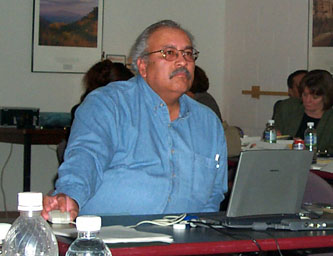
The sample size is generally limited either because researchers reach the end of a network or because of limited research project resources. After this sampling is done, it is possible to develop networks of decision makers and determine who are the people affected by decisions.
The fifth is to make sure that the teams have agreed on a research agenda. As implied above, the research methodology requires that the researchers structure their study around the knowledge of the people in the communities, not on a survey put together by researchers alone. As the method shows, however, structuring the interviews and observations around the knowledge of the people in the communities does not imply that the research is non-structured or in some other way free-form. The research is indeed highly systematic.
Nevertheless, this structuring around the knowledge of the community members does not mean that the research proceeds without an agenda. Thus, the fifth strategy is to identify a general agenda of research questions that need to be answered. These are based on the overview of tourism issues discussed above, and are a guide for the researcher. They do not comprise a survey questionnaire. Depending on the conditions of the interview, they can be grand tour or follow-up questions. Some of these questions may include:
- How has tourism impacted peoples' experiences in the past i.e., in their own communities and elsewhere they may have resided?
- What kinds of effects has tourism brought?
- What could improve present conditions in certain communities?
- What are examples of successful programs that have improved life in these communities?
- What places would local people want outsiders to visit and not visit?
- What about the local culture would people like one's fellow community members to know? I.e., among traditions/artifacts/language?
- What do local community members know about El Camino Real?
- What associations do people have with El Camino Real?
- What current cultural, local events could be connected to El Camino Real?
- What kinds of cultural products could people export or sell without sanitizing traditions?
- How do border issues affect tourism?
- What would be the problems of managed tourism—e.g., real estate, taxes, infrastructure, and traffic?
- What kinds of infrastructure or programs should be implemented to manage the effects of tourism (e.g. zoning)?
- Who might be included or excluded from the trail planning process?
The sixth is to conduct the REAP, selecting from the methods mentioned above that are appropriate to field conditions. The research will also include initial presentation of REAP results to community members. These presentations serve not only to verify findings, but also to elicit more information and structure the final report.
Finally, draft the final report.

